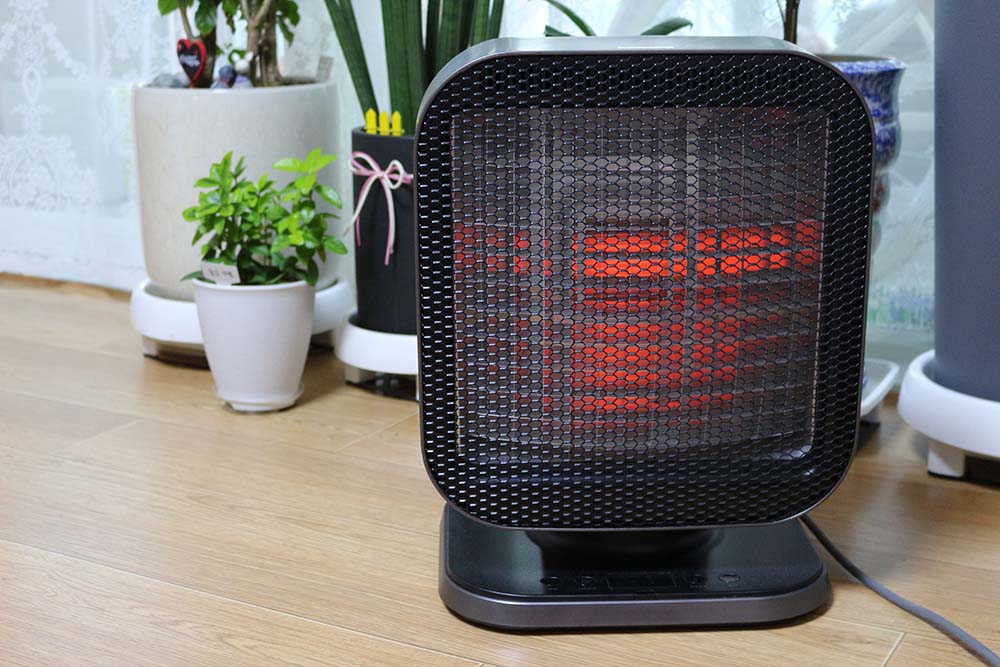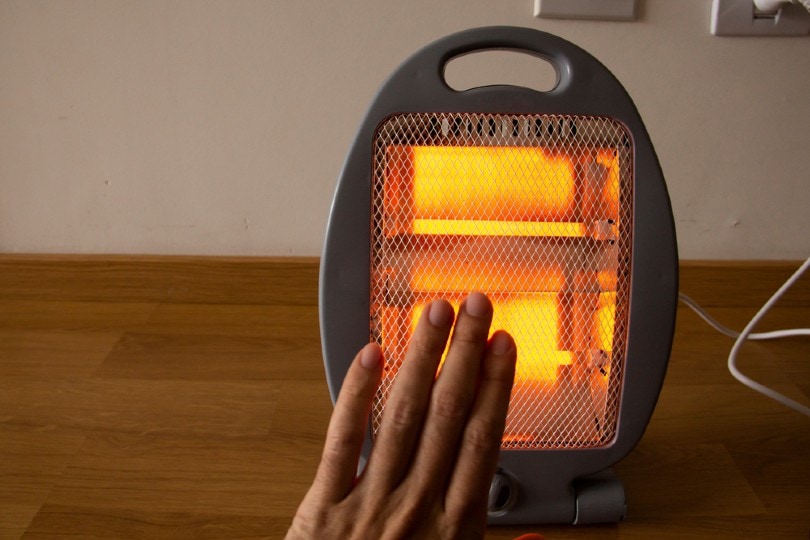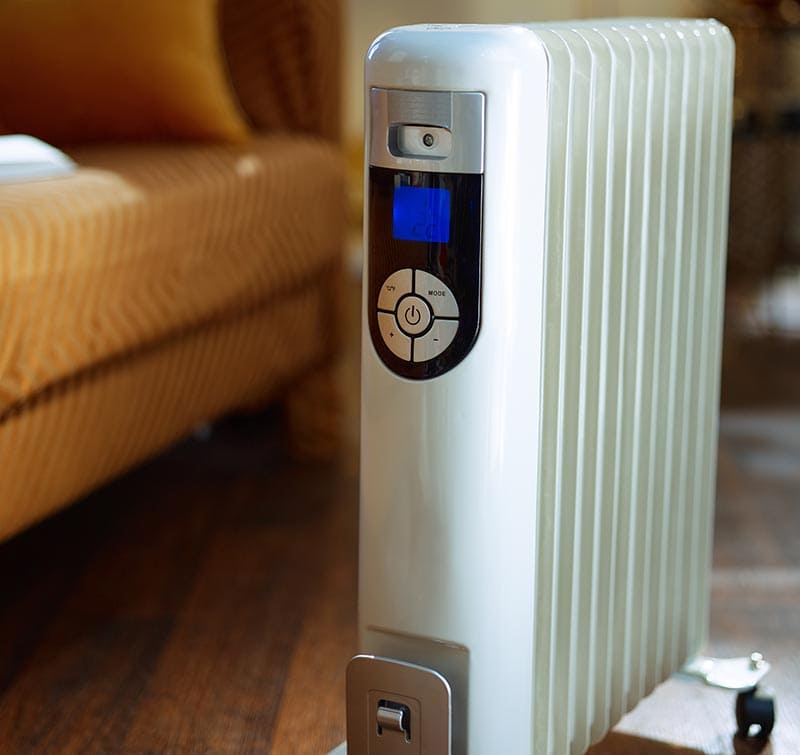4 Common Types of Space Heaters (With Pictures)
-
Pete Ortiz
- Last updated:

Space heaters should be a simple concept. You plug them in, and they get hot. But it is not as simple as that. In fact, when you dive into it, space heaters turn out to be much more complicated than most people expect. Space heaters often come with words like infrared, radiation, mica, fuel source, and oil medium. What do all of those words have to do with heating a home? Are these heaters safe? What can you expect if you buy one?
This guide will go over every common type of space heater and the individual heating elements that they use to warm you up. By the end, you should have a good idea of how different space heaters work, what they take to get hot, and if they are safe or not for certain spaces.
Here is everything you need to know about the different types of common space heaters.
There are four main styles of space heaters. These designs demonstrate how the heat is produced and spreads. A type of space heater doesn’t necessarily describe the heating element itself. The heating element is the part of the space heater that actually gets hot. For example, a convection space heater can use either electric coils or ceramic plates to create heat. The type of space heater does not necessarily tell you what type of heating method is being used.
The 4 Types of Space Heaters
Choosing a type of space heater and a heating element in combination is key to landing on a heater you feel comfortable using. These are the four main types of space heaters.
1. Convection
Convection space heaters are some of the most common space heaters you will encounter on the market. Convection heaters use a fan to distribute warm air into a room. Convection space heaters warm the area around them using a particular heating method, and then the fan blows the hot air through the space. Convection space heaters are great for indoor use in well-insulated rooms. Once the room is warm, you can turn the heating element off and keep the fan on. The fan will continue to circulate the warmed air, even when turned off and keep the room feeling warm. The downside is that it takes some time for the heater to warm the space, and you will not begin feeling noticeably warmer until enough air is heated.
2. Radiative

Radiative heaters use infrared radiation to provide heat. These heaters are great for spaces with poor insulation or open spaces. The radiation warms people’s skin directly, which eliminates the need for an air medium, vastly decreasing the effectiveness of insulation. Radiative space heaters often use electromagnetic waves to heat an area, and they can even heat objects like furniture rather than the air. Think of a microwave oven. When you put your food in, the food gets hot, but the air inside the microwave does not. That is similar to how a radiative space heater works.
Radiative heaters are often small and portable. They can also provide direct heat to a cold person in seconds rather than having to wait minutes for a large air mass to warm up. Some common radiative space heaters include infrared fireplaces. They can be effectively used indoors and outdoors.
3. Fuel Burning

Fuel burning spaces use flammable fuel to create a flame or heat base, which is used to generate heat. There are numerous different types of fuel burning space heaters. Many modern fuel burning space heaters run on either propane or natural gas. However, in some areas, you will still find wood stoves and pellet burners being used to heat a space. A wood burning stove used solely for heat generation is a good example of a fuel burning space heater.
Fuel burning space heaters can create a lot of heat and warm large areas. The downside is that you have to provide constant fuel to keep them running. These heaters are excellent choices for areas where electricity is not available such as outdoor job sites and campsites. Fuel burning space heaters can be used indoors as well, but they are more dangerous than other types of space heaters for indoor use.
4. Filler

A filler space heater works by heating a liquid medium to a high temperature. The liquid medium is heated using electricity. The hot liquid circulates through housing that looks like an old-fashioned radiator. The hot liquid moving through the tubes provides a lot of heat that is projected via natural convection. Filler space heaters can heat a small space very effectively and produce a ton of heat that can last for a long time even after the unit is turned off. The most common type of filler heater is an oil filled space heater.
The downside to filler space heaters is that they produce a very hot surface that can burn someone who touches it. It can also take a long time for the liquid inside the unit to heat to the appropriate temperature to provide noticeable heat. Ince the unit is warmed up, the heat generation is top-notch, but you might have to wait a little while for it to get going.
Types of Heating Elements
Heating elements are the parts of the space heater that actually get hot. Some heating elements are more dangerous, more efficient, or more practical than others. For example, in an oil filled space heater, the oil itself gets hot, but the heating element is an electric coil that heats the oil. The oil is what transfers and radiates heat telling you what kind of space heater it is, but the thing doing the actual heating is an electric coil inside the unit. For a natural gas heater, the heating element is a gas-fueled flame that produces heat.
These are the six most common heating elements that you will find in common space heaters.
1. Infrared
Infrared heating elements produce electromagnetic waves to generate heat directly on an object. These heaters do not heat the air, and they are rarely hot to the touch. They are safe to tip over and can be used indoors with few risks. Infrared heaters can cause painful skin burns if you spend too much time too close to the unit. The skin will start feeling prickly and painful, similar to a sunburn.
2. Natural Gas / Propane
Natural gas and propane heating elements use gas to fuel a flame that, in turn, heats a space. Natural gas and propane heating elements produce a lot of heat and have plentiful fuel. They are good for areas without electricity or in large drafty spaces that are hard to heat with other types of space heaters.
Natural gas and propane are very effective, but they can be dangerous. The flames they produce are hot to the touch, and if you tip them over or have an accident, the units could cause a fire. Generally, these types of space heaters are rarely used indoors unless they are a part of an electric fireplace due to the fire risk. You do see these space heaters outdoors quite a bit. Standing propane heaters are a common way to heat outdoor dining and patio spaces.
3. Electric Heating Coil
Electric heating coils are some of the most basic and most common forms of a heating element. Electric coils take electricity and heat metal coils until they glow red hot. Old stove burners were a perfect example of how electric coils heat objects. In many convection heaters, electric coils simply heat the air inside the space heater, which is then blown out by a fan. Electric coils can also be used in other types of space heaters, such as radiator and filler heaters, where the coils heat different mediums that are used to produce heat.
Enclosed electric coils are generally safe, but they can still post a minor fire risk, burn risk, and shock risk. Exposed electric coils are much more dangerous than enclosed heating coils.
4. Micathermic
Micathermic heating elements are very unique. They combine radiative and electric coil heating methods into one package that has the benefits of both. When electricity is run through mica, a type of mineral found commonly on Earth, the rock heats up. Instead of getting hot to the touch like an electric heating coil, the rock begins to transmit electromagnetic waves that similarly heat the room as infrared heaters. Micathermic heating elements are generally displayed in large flat panels that emit radiative heat into a room. They do not heat the air like other types of heating elements.
5. Ceramic Plate
Ceramic plate heating elements take electricity and use it to heat up flat ceramic plates. Once the ceramic plates are hot, they begin to heat the air around them. Unlike micathermic heaters, ceramic plates get hot to the touch and heat the air instead of nearby objects. Ceramic plates are often used as the heating element in space heaters with fans. The fans will blow the hot air coming off of the ceramic plates. Ceramic plates are such an effective heating element that some units do not even need a fan. Ceramic plates get hot almost instantaneously and can heat a room extremely quickly, making them a popular choice as an indoor heating element.
6. Reflective
Reflective heating elements are unique in that they do not produce heat from a source like electricity or infrared waves. Instead, they focus and trap heat in a certain area or redirect existing heat to another area. Reflective heating elements are not as commonly used in space heaters, but they are commonly used in many other objects around the home. Reflective heating elements keep air ducts hot or cold. They are also used inside coolers, space blankets, greenhouses, and other warming items that do not use any sort of power source. Reflective heaters can be used in remote areas with access to strong sunlight to heat a space without any need for fuel or power.
Combining A Type of Heater and a Heating Element
The key to picking a space heater that is right for you involves choosing the perfect combination of heater and heating element. If you have a large garage workshop that is free from kids and pets but gets extremely cold in the winter, you might opt for a propane heater. If you have a small living room that is drafty but doesn’t need a lot of heat, you might want to get a micathermic radiative heater.
Some heating elements are more dangerous than others. Some elements are more expensive than others. Some heaters are great for small spaces, while others are better suited for large spaces. Figuring out your individual heating needs and taking this information to heart will allow you to choose a space heater that is comfortable, safe, and effective for you.
- You might aslo like: When Is the Best Time To Buy Patio Furniture?
Conclusion
There are a lot of ways to get warm in the winter. With numerous different types of space heaters and heating elements, there are heaters of all shapes and sizes suitable for all sorts of different needs. Whether you need a hot blue flame to pump heat into an outdoor event space or a small electric coil to keep an office warm, there are space heaters of every stripe designed to keep people warm when everything else is cold.
- Related Read: The 8 Best Infrared Space Heaters
Featured Image Credit: Hello_ji, Shutterstock
Contents


